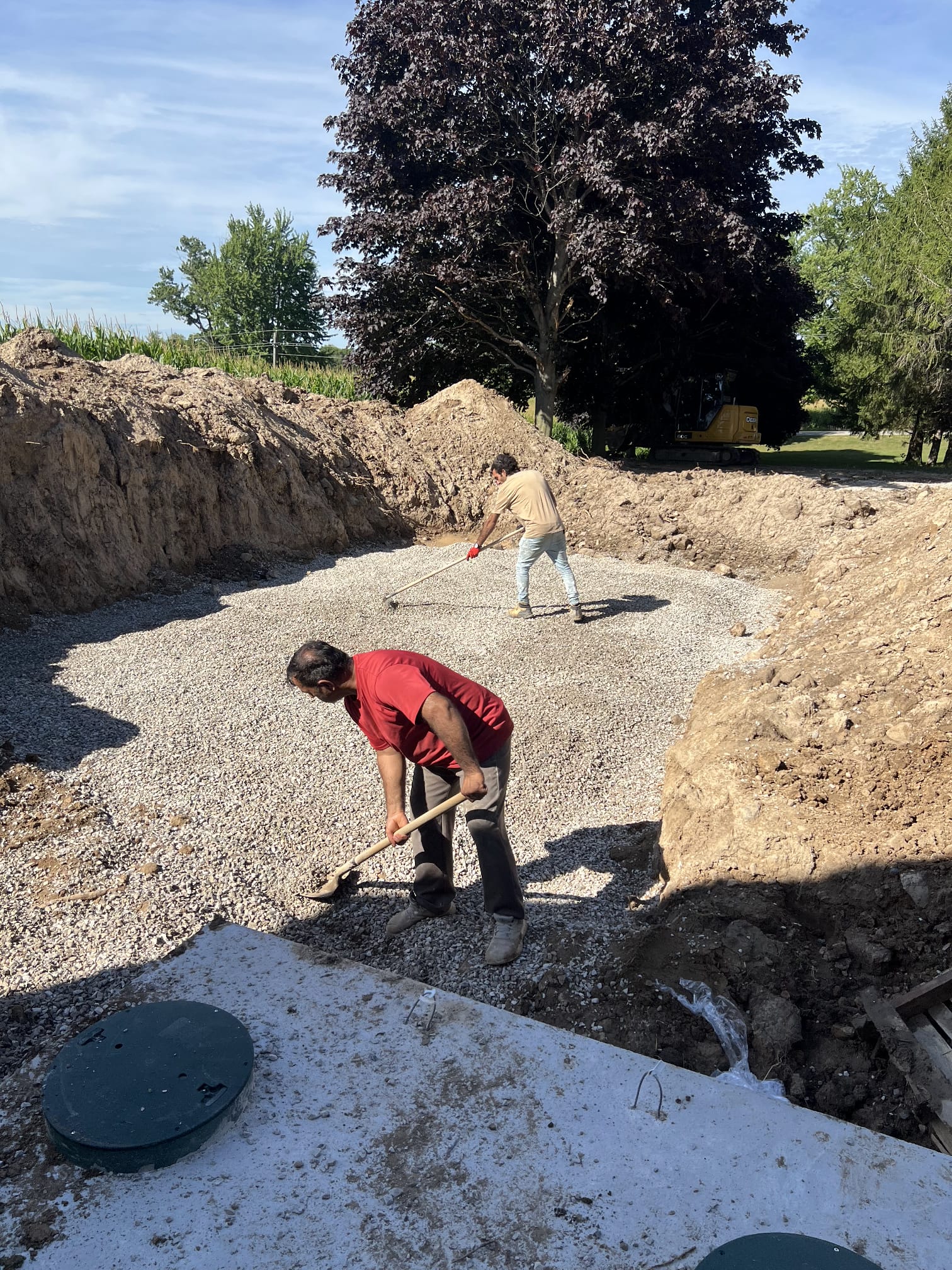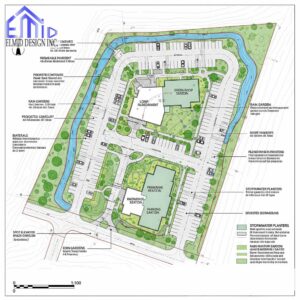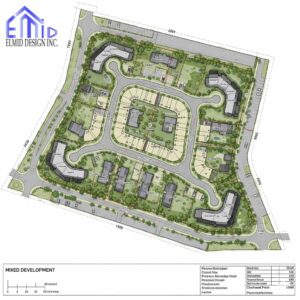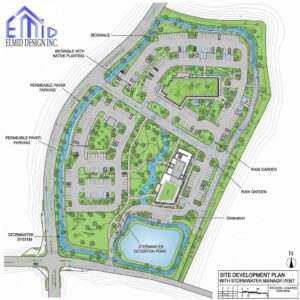If you plan to build or renovate a property in Caledon, you need a well-designed septic system. Many rural parts of Caledon lack municipal sewer connections, so every home or business depends on an individual on-site sewage disposal system. A septic design Caledon plan shows how wastewater moves through the system and how it’s treated before safely returning to the ground without harming soil or groundwater. A skilled engineer designs the system to work efficiently, protect the environment, and comply with all local and provincial standards. Partnering with Elmid Design Inc., a licensed engineering firm authorized by the Professional Engineers Ontario (PEO), ensures your system meets professional standards and regulatory expectations while supporting long-term property value.
What Septic Design Caledon Means
Septic design Caledon is a comprehensive process that begins long before installation. It involves collecting data, analyzing soil conditions, and designing a system tailored to the site’s specific characteristics. Each property in Caledon is unique, with its own slope, soil texture, and drainage behavior. These factors determine how wastewater is absorbed and treated by the ground. A complete septic design includes the layout of the tank, distribution pipes, leaching bed, and reserve area for future expansion. It also details the size and type of system, such as a conventional leaching bed or an advanced tertiary treatment unit. This design is not just a technical drawing—it is an engineered plan that ensures your system performs safely and efficiently for decades.
The Role of Local Regulations in Septic Design Caledon
Septic systems in Caledon are governed by the Ontario Building Code, which outlines specific design and installation standards. The Code specifies how large a system must be based on the number of bedrooms, fixture units, and daily wastewater flow. It also requires the separation of sewage systems from wells, property lines, and watercourses to prevent contamination. Before any construction begins, the Town of Caledon must review and approve the proposed septic design to ensure full compliance. This regulatory framework protects both the homeowner and the environment. Licensed engineers are familiar with these local requirements, and they incorporate them into every project submission. By following the municipal and provincial standards, you can avoid permit delays, costly redesigns, and potential penalties for non-compliance.
Site Evaluation and Soil Testing for Septic Design Caledon
A successful septic design Caledon project starts with a detailed site evaluation. The engineer visits the property to observe terrain, vegetation, drainage, and slope. These visual clues reveal how surface water behaves and whether the area is suitable for a leaching bed. Next, soil testing—often called a percolation or permeability test—is conducted to measure how quickly water is absorbed into the ground. The results determine the depth and type of leaching bed required. Clay soils, for instance, absorb water slowly and may need a larger bed or a raised system, while sandy soils allow faster infiltration but require protection against overloading. Accurate testing ensures the septic system’s longevity and efficiency by matching the design to the natural characteristics of the land.
Design Preparation and Documentation Process
Once the site data and soil test results are ready, the engineer begins the design phase by creating a scaled site plan that shows all buildings, driveways, wells, and nearby water features. The engineer places the septic system layout directly on this plan and ensures every component meets regulatory setbacks. The design package includes technical drawings, calculations, and notes that define materials, dimensions, and elevations. The engineer attaches supporting documents such as design summaries, soil test results, and permit forms to complete the submission. After final review, the engineer delivers the package to the municipal building department for official approval. This documentation confirms compliance, establishes design integrity, and creates a permanent record for future maintenance, upgrades, or property transactions.
Importance of Professional Engineering in Septic Design Caledon
In Caledon, a septic design is considered a regulated activity under the Ontario Building Code. While some small residential systems may be designed by qualified designers, complex or large-capacity systems require professional engineering oversight. Elmid Design Inc., authorized by the Professional Engineers Ontario, provides this level of technical assurance. Engaging a professional engineer means your design will include accurate calculations, safety margins, and compliance with the latest standards. It also ensures accountability—engineers must stamp and sign their designs, accepting professional responsibility for their accuracy. Homeowners benefit from this expertise through improved system reliability, fewer failures, and faster permit approvals. A professionally prepared design adds credibility when selling or refinancing a property, as it demonstrates compliance with provincial law and environmental protection standards.
Steps in a Septic Design Caledon Project
The process begins with a client consultation to discuss the property layout, water usage, and future development plans. The engineer then performs the site visit and soil analysis to collect all technical data. Using this information, the designer determines the system type that best suits the site conditions. Design options may include conventional systems, shallow buried trenches, raised filter beds, or advanced treatment units. After selecting the appropriate type, the engineer creates detailed design drawings and specifications. Once the design package is submitted, the municipal authority reviews it and issues a permit if it meets the requirements. The approved design guides contractors during installation, and inspections confirm compliance before final approval. Each step is structured to reduce risks, ensure public safety, and maintain environmental integrity.
Why Soil Conditions Matter in Caledon
The diverse geography of Caledon means soil conditions can vary widely from one property to another. In some areas, you’ll find sandy loam that offers excellent drainage, while others contain clay that restricts water movement. Understanding these soil conditions is central to septic design Caledon. Engineers interpret soil test data to determine absorption rates and ensure that effluent is properly treated before reaching groundwater. The wrong system type or bed size can lead to premature failure, unpleasant odors, and environmental contamination. Correctly analyzing and designing for local soil behavior not only protects water quality but also extends the lifespan of your septic system, reducing long-term maintenance costs for homeowners.
Selecting the Right Design Partner in Caledon
Choosing a qualified professional is one of the most important steps in septic system planning. A licensed engineer familiar with Caledon’s terrain and municipal process can save you time and money. Elmid Design Inc. exemplifies this expertise with a strong background in residential and commercial septic designs. The company’s certification through the Professional Engineers Ontario ensures that each project is completed to the highest professional standard. By working with an authorized engineering firm, homeowners gain confidence that every technical detail—from soil evaluation to final inspection—meets both code requirements and environmental best practices. The right design partner ensures not only compliance but also system durability, efficiency, and long-term property value.

Types of Septic Systems Used in Caledon
A proper septic design Caledon plan begins with selecting the right system type for the property. The two most common systems are conventional gravity systems and advanced treatment units. Conventional systems use a tank and a leaching bed where wastewater filters through soil for treatment. Advanced systems use mechanical or biological components to enhance treatment before effluent reaches the ground. Engineers assess soil type, groundwater depth, and lot size before recommending a system. In Caledon, advanced systems are often required where site conditions limit natural absorption. Choosing the correct type helps maintain system performance and reduces the risk of contamination.
Conventional Septic Design Caledon Systems
Conventional systems are common in areas with good drainage and deep permeable soils. Wastewater from the home enters a two-chamber septic tank where solids settle and begin decomposition. The clarified liquid then flows to a distribution box that sends the effluent evenly to the leaching bed. Each trench in the bed allows effluent to filter through gravel and soil, providing natural purification. In Caledon, this design remains reliable and cost-effective when soil testing confirms adequate percolation. Engineers ensure the layout maintains proper separation from wells and watercourses. Routine inspections confirm that the system continues to operate safely over time.
Advanced Treatment Systems in Septic Design Caledon
Some Caledon properties require advanced treatment systems due to poor soil, high groundwater, or small lot size. These systems use additional treatment stages such as aeration, filtration, or disinfection to clean wastewater before it enters the soil. Examples include aerobic treatment units and tertiary filter systems. The effluent quality from these systems is higher, reducing environmental risk and protecting groundwater. Although advanced systems cost more to install, they allow development on sites unsuitable for conventional systems. Engineers at Elmid Design Inc. assess these factors carefully to design efficient and compliant advanced systems tailored to local conditions in Caledon.
Cost Factors in Septic Design Caledon
The cost of a septic design Caledon project varies based on system type, soil conditions, and site complexity. A simple residential system in favorable soil may require a smaller leaching bed and fewer components. More complex sites, such as sloped or clay-based lots, need engineered solutions that raise the total cost. Design and permit fees, soil testing, and materials also contribute to the final price. Professional engineering design from Elmid Design Inc. ensures accurate sizing and efficient use of materials, which helps control overall expenses. Investing in proper design upfront prevents future system failure and costly repairs, making it a long-term value for homeowners.
Permit and Approval Process for Septic Design Caledon
Before installation begins, the septic design must be reviewed and approved by the Town of Caledon’s building department. The process starts when the engineer submits drawings, test results, and design notes to confirm compliance with the Ontario Building Code. Once reviewed, the municipality issues a permit authorizing construction. During installation, inspections verify that the system matches the approved design. If all standards are met, final approval is granted, allowing the system to operate legally. Using a certified engineer simplifies this process because their documentation meets the precise format and technical standards expected by local authorities.
Installation Phase of a Septic Design Caledon Project
After the design and permit receive approval, the contractor begins construction. The crew excavates trenches or builds raised beds according to the engineered drawings. They install the septic tank, piping, and distribution components using exact measurements to maintain balanced flow. Workers backfill the area carefully to prevent damage and maintain the correct slope. Engineers visit the site during installation to confirm compliance and resolve technical challenges immediately. When construction ends, engineers perform a full inspection and testing process before approving the system for operation. Accurate installation ensures reliable performance and extends the system’s lifespan.
Maintenance Requirements for Septic Design Caledon Systems
Every septic design Caledon system requires consistent maintenance to function effectively. Tanks should be inspected and pumped every three to five years, depending on household usage. Filters must be cleaned to maintain flow and prevent backups. Homeowners should avoid flushing non-biodegradable items and limit the use of harsh chemicals that disrupt bacterial activity. Regular maintenance not only protects the environment but also preserves the design’s efficiency. Engineers recommend keeping detailed records of pumping and inspection dates for future reference. Maintaining the system based on the original engineered design ensures long-term reliability and reduces the likelihood of expensive repairs.
Common Issues in Septic Design Caledon Systems
Poor design, overuse, or neglected maintenance can cause septic systems to fail. Common signs include slow drains, unpleasant odors, or pooling water above the leaching area. In Caledon, heavy clay soil can cause saturation, leading to backups and uneven effluent distribution. Tree roots can also damage piping and compromise the system. When issues occur, engineers should inspect the site to identify the cause and recommend corrective action. Proper design by a licensed professional minimizes these risks. A well-engineered and properly maintained system can last decades while continuing to meet health and environmental standards.
Environmental Protection and Septic Design Caledon
Environmental stewardship is a key consideration in every septic design Caledon project. The design must ensure that wastewater is fully treated before it reaches groundwater or surface water sources. Soil filtration and bacterial action play an essential role in breaking down contaminants. Systems designed without proper engineering oversight risk contaminating wells and nearby streams. By hiring professional engineers, property owners help protect local ecosystems and comply with environmental regulations. This approach aligns with Caledon’s commitment to sustainable development and clean water preservation for future generations.
Role of Elmid Design Inc. in Septic Design Caledon
Elmid Design Inc. provides professional engineering services for septic system design, site evaluation, and permit preparation in Caledon and surrounding areas. As a firm authorized by the Professional Engineers Ontario, it upholds strict ethical and technical standards. The team combines engineering expertise with local regulatory knowledge to deliver reliable, cost-effective designs. Each project is handled with precision, ensuring compliance, safety, and long-term performance. Homeowners and builders benefit from detailed guidance throughout the process—from soil testing to municipal approval. The company’s engineering integrity supports Caledon’s growing need for sustainable and compliant wastewater solutions.
Homeowner Responsibilities After Septic Design Approval
Once a septic design Caledon project receives final approval, the homeowner becomes responsible for its long-term care. The design only functions properly when regular maintenance and inspections occur as scheduled. Homeowners must follow the engineer’s guidance regarding system loading, pumping intervals, and protection of the leaching area. Avoiding heavy traffic, tree planting, or construction over the bed helps preserve its integrity. Adhering to these maintenance steps ensures the system continues to operate efficiently and meets the original design performance goals set by the engineer.
Preparing for Septic System Inspections in Caledon
Periodic inspections confirm that the system continues to meet safety and environmental standards. During an inspection, a licensed professional checks tank levels, filter condition, and effluent clarity. Engineers also verify that drainage remains consistent with the approved design. Property owners in Caledon should maintain clear access to septic lids and keep records of previous reports. Inspection results often determine whether the system needs cleaning or adjustment. Scheduling regular evaluations keeps the system compliant and extends its lifespan while protecting local groundwater.
Signs That Indicate Septic Design Caledon System Problems
A septic design Caledon system can show early warning signs of trouble if performance declines. Wet spots near the leaching area, foul odors, or gurgling drains usually indicate overloading or clogging. Sluggish toilets and backups often point to full tanks or damaged components. When these symptoms appear, immediate assessment by an engineer or licensed contractor prevents major damage. Early intervention reduces repair costs and restores normal operation. Addressing small issues quickly helps maintain public health and safeguards surrounding soil and water quality.
Upgrading and Replacing Older Septic Systems in Caledon
Many older properties in Caledon use outdated septic systems that no longer meet modern design standards. Upgrading or replacing these systems enhances treatment performance and compliance. Engineers start by reviewing existing layouts and soil conditions before recommending suitable upgrades. Replacements often include advanced filtration, aeration, or tertiary treatment to reduce environmental impact. New designs improve wastewater efficiency while aligning with current Ontario Building Code requirements. Partnering with Elmid Design Inc. ensures that the updated system integrates advanced technology and engineering precision for long-term sustainability.
Sustainable Practices in Septic Design Caledon
Sustainability is becoming a leading priority in every septic design Caledon project. Engineers now use environmentally responsible methods and materials that minimize groundwater contamination. System layouts are optimized to reduce excavation, preserve natural drainage, and protect native vegetation. Water-saving fixtures inside the home reduce daily effluent volume, lowering the load on the leaching bed. Combining proper design with conscious water use extends system life and reduces environmental stress. Sustainable practices not only protect Caledon’s landscape but also reflect a community commitment to clean water and responsible development.
Role of Engineers in Long-Term Septic System Performance
An engineer’s role does not end once the permit is issued. For continued reliability, engineers provide ongoing consultation and inspection services. In Caledon, firms such as Elmid Design Inc. assist property owners in maintaining their systems according to regulatory standards. Engineers can analyze performance trends, recommend improvements, and guide homeowners through any required re-inspections. Their technical expertise ensures that system integrity and public safety remain consistent over time. Maintaining a relationship with your design engineer provides reassurance that every issue will be addressed using professional judgment and proven solutions.
Education and Awareness in Septic Design Caledon
Homeowner education plays an essential role in extending the life of a septic system. Understanding how wastewater treatment works helps residents make smarter decisions about daily water use. Simple habits such as spacing out laundry loads, fixing leaks promptly, and avoiding harmful chemicals reduce system stress. Engineers often provide detailed maintenance manuals after completing the design. These materials explain how to interpret inspection results and recognize potential warning signs. Increased awareness empowers homeowners to act quickly and responsibly, preventing premature system failure and environmental damage.
The Future of Septic Design Caledon
The future of septic design Caledon is moving toward innovation and sustainability. New treatment technologies are making systems smaller, smarter, and more efficient. Automation allows remote monitoring, helping engineers detect issues early and reduce maintenance costs. As Caledon’s population grows, local authorities continue updating guidelines to protect water quality. Engineering firms with strong technical foundations, such as Elmid Design Inc., lead this transformation by integrating research and technology into practical design solutions. The focus remains on creating systems that serve homeowners reliably while preserving Caledon’s natural environment for generations.
Frequently Asked Questions About Septic Design Caledon
What does a septic design Caledon project include?
A septic design Caledon project includes a full site evaluation, soil testing, and a detailed engineering plan showing all system components. It also includes technical drawings, calculations, and documentation for municipal approval.
How long does septic design approval take in Caledon?
Approval time varies depending on municipal workload and the complexity of the project. Most residential designs receive review within a few weeks when documentation is complete and compliant with the Ontario Building Code.
Who is qualified to design septic systems in Caledon?
Only licensed designers or professional engineers authorized by the Professional Engineers Ontario can prepare septic system designs. Engaging a certified firm such as Elmid Design Inc. ensures professional accountability and regulatory compliance.
What factors affect the cost of septic design Caledon systems?
The main factors include soil type, property slope, system type, and accessibility. Complex sites or advanced systems require more detailed engineering, which increases overall cost but improves long-term performance.
How often should septic systems in Caledon be inspected or pumped?
Most systems should be inspected annually and pumped every three to five years. Frequency depends on household size, water usage, and the original design capacity specified by the engineer.
What happens if my septic system fails in Caledon?
If a system fails, the property owner must contact a licensed engineer or designer immediately. They will assess the problem, prepare a new design or repair plan, and coordinate approvals with the municipality to restore compliance.
Can older systems be upgraded without full replacement?
Yes, some existing systems can be retrofitted with advanced treatment units or filter upgrades. Engineers assess soil conditions and tank integrity to determine if partial modernization is possible without complete reconstruction.
Why choose Elmid Design Inc. for septic design Caledon projects?
Elmid Design Inc. offers engineering expertise, regulatory knowledge, and PEO authorization that guarantee compliance and quality. Their designs balance efficiency, environmental protection, and cost-effectiveness, providing lasting value to Caledon homeowners.

Trusted Engineering Experts for Septic Design Caledon
Elmid Design Inc. is a licensed engineering firm recognized by the Professional Engineers Ontario (PEO) for its technical excellence and professional integrity. The company specializes in septic design Caledon projects, offering complete engineering solutions from soil testing to permit approval. With a focus on accuracy, compliance, and sustainability, Elmid Design Inc. ensures every system is designed for efficiency and long-term reliability. Homeowners and builders across Caledon trust the firm’s expertise to deliver innovative, code-compliant designs that protect the environment and add value to every property.
Geographic Locations That We Service:
Our Licensed Professional Engineers specializing in Engineered Site Grading Plans offer the best-engineered site grading plan, lot grading and erosion plan, and drainage plan to obtain site plan approval and building permits in Ontario, including a wide range of municipalities. Each area boasts unique features and requirements, making our tailored approach essential for success.
Toronto and Surrounding Areas
In the vibrant heart of Ontario, we service Toronto (City of Toronto) and surrounding areas. Additionally, we cover Oshawa (City of Oshawa), Pickering (City of Pickering), and Clarington (Municipality of Clarington). Furthermore, our expertise extends to Ajax (Town of Ajax), Whitby (Town of Whitby), Brock (Township of Brock), Scugog (Township of Scugog and Uxbridge (Township of Uxbridge).
Halton Region
Moving to the Halton Region, our services encompass Burlington (City of Burlington) and Halton Hills (Town of Halton Hills). Also included are Milton (Town of Milton) and Oakville (Town of Oakville).
Peel Region
In the Peel Region, we provide services in Brampton (City of Brampton), Mississauga (City of Mississauga), and Caledon (Town of Caledon).
York Region
Our services in the York Region cover Vaughan (City of Vaughan), Aurora (Town of Aurora), and East Gwillimbury (Town of East Gwillimbury). We also cater to Georgina (Town of Georgina), Markham (City of Markham), Newmarket (Town of Newmarket), Richmond Hill (City of Richmond Hill), Whitchurch-Stouffville (Town of Whitchurch-Stouffville), King (Township of King), and Bradford-West Gwillimbury (Town of Bradford-West Gwillimbury). Each municipality here offers a distinct setting, requiring our specialized approach.
Other Southern Ontario Cities and Towns
We also serve many other cities and towns in Southern Ontario. These include Hamilton (City of Hamilton), St. Catharines (City of St. Catharines), Niagara on the Lake (Town of Niagara on the Lake), Brant (County of Brant), Cambridge (City of Cambridge), Kitchener (City of Kitchener), Waterloo (City of Waterloo), and Woodstock (City of Woodstock). Furthermore, we operate in Guelph (City of Guelph), Centre Wellington (Township of Centre Wellington), Shelburne (Town of Shelburne), Orangeville (Town of Orangeville), New Tecumseth (Town of New Tecumseth), Essa (Town of Essa), Collingwood (Town of Collingwood), Wasaga Beach (Town of Wasaga Beach), Barrie (City of Barrie), Midland (Town of Midland), Orillia (City of Orillia), Ramara (Town of Ramara), Minden Hills (Town of Minden Hills), North Kawartha (Town of North Kawartha), Kawartha Lakes (City of Kawartha Lakes), Peterborough (City of Peterborough), Selwyn (Town of Selwyn), and Brighton (Municipality of Brighton).




